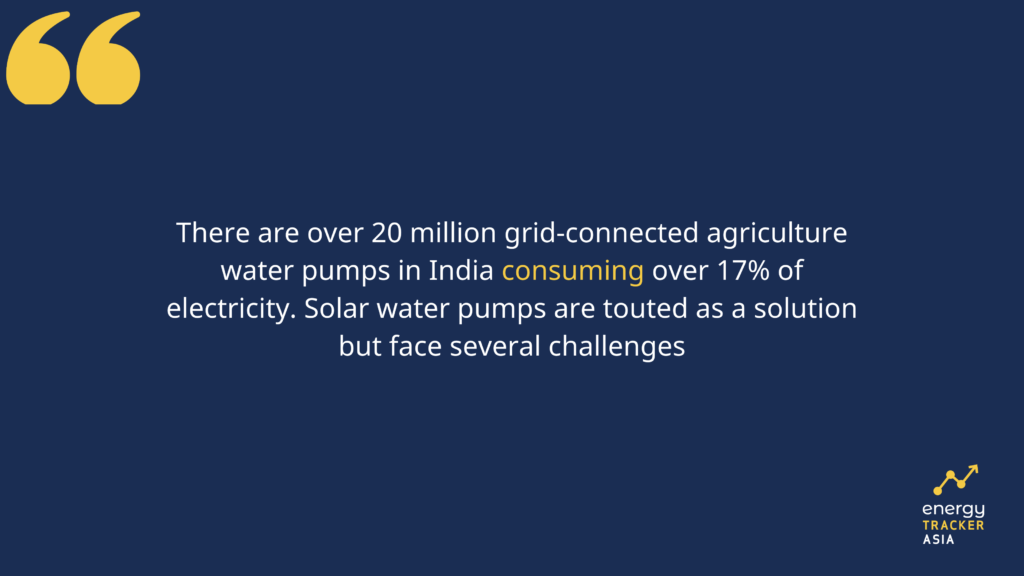Kusum: India’s Agriculture Solar Pump Scheme Facing Challenges
By IWMI Flickr Photos is licensed under CC BY-NC 2.0
21 September 2021 – by Ankush Kumar Comments (0)
The Indian government launched its mega solar pump scheme PM Kusum Yojana, also popularly known as PM Kusum, in 2019. The scheme aims to improve farmers’ income by installing grid-connected solar pumps up to 2 MW and transform existing diesel pumps into solar. While the larger goal was to develop decentralised solar energy systems, it also focuses on reducing power transmission and distribution losses. The scheme focuses on addressing many issues from rural development to renewable energy transition. However, PM Kusum Yojana has not been able to match the desired timelines. There are now questions regarding its sluggish progress.
Energy Transition in Agriculture through Solar Pumps
According to the data from Kusum’s guideline published in July 2019, India is home to 30 million agriculture pumps. Out of this, around 10 million runs with diesel. As the power companies could not electrify these diesel pumps, the government’s solar pump scheme planned to replace them with solar water pumps. Government data counts over 20 million grid-connected agricultural water pumps. They consume more than 17% of the total annual electricity of the country. Powering these pumps with solar energy will reduce the dependence on the already stressed power distribution companies.
The Scope of Kusum Agriculture Solar Pump Scheme
As per the country’s new and renewable energy ministry, the scheme aims to achieve a solar capacity of 30.8 GW by 2022. The central government promises financial support of about USD 4.7 million. The solar pump scheme scheme has three main components: the setup of 10,000 MW decentralised grid-connected renewable energy power plants. The second step foresees the installation of two million stand-alone solar agriculture pumps with an individual capacity of up to 7.5 horsepower. Lastly, the scheme aims at solarising 1.5 million grid-connected agriculture pumps.
Kusum aims at benefitting India’s 3.5 million farmers. They can sell the surplus power generated from these solar pumps directly to the power distribution companies. It also lets farmers to utilise barren land by installing a solar plant which improves their livelihoods. In essence, creating a solar water pump market for agriculture.

Financial Assistance to Adopt Solar Energy
Under PM Kusum Yojana, the central government will provide 30% of the financial assistance for the stand-alone solar pump. State governments will also provide a 30% subsidy, with farmers making up the remaining 40%. Additionally, farmers are eligible for bank loans of up to 30% of the financing needs. As a result, farmers only have to provide 10% upfront in cash. However, in some states, the central governments financial assistance grows up to 50% on stand-alone agriculture solar pumps.
Lack of Progress in Kusum
Experts consider Kusum as one of the most transformational schemes in the renewable energy sector. However, it has not met expectations and is way behind intended targets. The Institute for Energy Economics and Financial Analysis (IEEFA) raises such doubts in a report. Accordingly, out of the planned 2 million off-grid solar-powered irrigation pumps, only one-eighth are operational. “A total of around 246,000 solar pumps were deployed. And only 8,900 of these were installed in the 12 months after the scheme was launched in 2019,” found the report.

Roadblocks in Expansion
To meet India’s agricultural demand, farmers in India can get electricity at a subsidised rate. IEEFA estimates that PM Kusum Yojana can save the Indian government up to USD 7.6 billion. However, IEEFA, in its report, also highlighted major roadblocks in the solar pump scheme leading to delayed expansion. It pinpoints the lack of coordination among the implementation agencies and the government departments. It also underlines the challenges related to farmers receiving bank finance, ambiguity in opting for suitable business models and other technological issues.
Depleting Groundwater and Over-extraction
The other major shortcoming of this solar pump scheme is its long-term impact on the groundwater. In its report, a Delhi-based NGO, Center for Science and Environment (CSE), highlights that large-scale distribution of pumps could result in excessive water withdrawal. Consequently, this could effect already depleting groundwater levels.
“Widespread deployment of solar pumps in water-scarce regions could create more problems than they solve unless over-extraction of groundwater is prevented,” said CSE. The NGO recommended a redesign of the scheme focusing on water and agriculture also, and not merely on renewable energy.

India’s renewable energy power minister, RK Singh shared his views on the using pumps in water scarce regions in 2021. These areas are known as “dark zones” in the PM Kusum Yojana Scheme. Singh stated that the Central Ground Water Board (CGWB) from time to time notifies the areas for control and regulation of groundwater. “Only existing pumps can be solarised in the ‘dark zones’,” said Singh. “So far, no existing grid-connected pumps are reported solarised under the solar pump scheme in ‘dark zones.'”
New and Renewable Energy Outlook for India
According to the minister, as of 2021, a total of 24,688 stand-alone solar pumps were running. Additionally, solar systems now equip 64 grid-connected agriculture pumps. The Indian government has set a target to achieve 450 GW of renewable energy capacity by 2030. So far, the country has achieved 98.88 GW of renewable energy capacity, excluding energy generation from large hydro projects.



